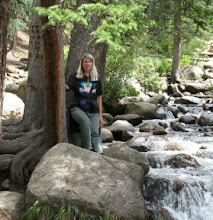 I'm not sure she understood when I explained about
I'm not sure she understood when I explained about Buy Nothing Day, a bright spot in the "let's-start-Christmas-before-we-get-through-Halloween" madness that is fall in our cultural milieu.* Putting Pilgrim associations far aside, Thanksgiving is a holiday that has redeeming social value and is connected to the Earth much in the way of an old pagan harvest festival. Unfortunately, as only grocery stores get much economic boost from it, this moment to stop and consider one's blessings is in danger of being overrun by the more critical need to keep the economy humming along. I'm with the folks at Adbusters, who say:
There’s only one way to avoid the collapse of this human experiment of ours on Planet Earth: we have to consume less.
*Wikipedia will fill you in on the downside of Buy Nothing Day, a holiday for the 'haves' perhaps, but where else can we find criticism of Black Friday?
As for me, I've reached that age where I have the basic stuff I need and, the Darling Husband would say, too much of most of it. I need to develop skills in "enlightenment" instead—lightening my load on the planet by finding homes for some of the "stuff" I've managed to accumulate these last 30 years or so. (A DH quote: "You don't help the environment by turning the house into a landfill.")
 It's true: A victim of early Earth Day conditioning [There is no "away"], and knowing the fate of most trash, I don't throw things away like I should. (Some of it, for example, ends up on this beach in Hawai'i; photo right.) I'm convinced there must be someone out there who needs or appreciates these trinkets as much as I do—I just haven't located them yet! ( With the possible exception of my 24-year-old niece, who is at the "I want" stage, and makes a good repository for excess crockery and glassware, as well as tidbits from my yarn collection and other unfinished projects.)
It's true: A victim of early Earth Day conditioning [There is no "away"], and knowing the fate of most trash, I don't throw things away like I should. (Some of it, for example, ends up on this beach in Hawai'i; photo right.) I'm convinced there must be someone out there who needs or appreciates these trinkets as much as I do—I just haven't located them yet! ( With the possible exception of my 24-year-old niece, who is at the "I want" stage, and makes a good repository for excess crockery and glassware, as well as tidbits from my yarn collection and other unfinished projects.) I lean toward the recognition of "useful life left," even in items that are missing pieces or otherwise in need of repair. Yes, perhaps it could be taken to the thrift stores most of it came from in the first place, but some is even beyond that stage. Hesitation, resistance to disposal, also arises from reading Wendell Berry, who once remarked:
Our great fault as a people is that we do not take care of things. Our economy is such that we say we 'cannot afford' to take care of things: Labor is expensive, time is expensive, money is expensive, but materials—the stuff of creation—are so cheap that we cannot afford to take care of them.
Berry was not, of course, the first to notice this trend. In googling to find that quote again, I ran into an interesting "transhistorical and transcultural approach to trash," which contains (scroll down) a long timeline of trashy tidbits, including this one:
Our willingness to part with something before it is completely worn out is a phenomenon noticeable in no other society in history… It is soundly based on our economy of abundance. It must be further nurtured even though it runs contrary to one of the oldest inbred laws of humanity, the law of thrift.
- J. Gordon Lippincott, industrial designer, 1947
Ah, thrift... now there's a word you don't hear every day.
So, although my car is out of gas, there's an item on ebay I covet, and we're low on chicken feed, I'll be staying home today.












